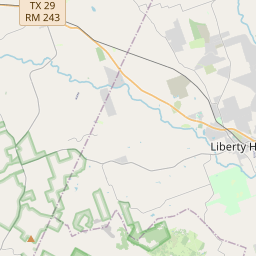San Gabriel Park
Historical marker location:






The land and springs around this site made it a favored camping site for local Indian tribes for centuries before the Spanish discovered it. Raids, drought and conflict led the Spanish to abandon the area in 1756. The Mexican State of Coahuila and Texas granted a colonization contract to Robert Leftwich in 1825. Conflicting contracts were granted to Stephen F. Austin and Sterling C. Robertson. George W. Glasscock, Sr. (1810-1868) purchased the land while speculating for Thomas B. Huling and Company. In 1839 Glasscock received two headrights including this land as part of his share of assets when the company dissolved.
The site had become a popular gathering place for settlers when Sam Houston spoke here in 1859. It became known as "The Fairgrounds." Large annual fairs, reunions and religious revivals drew crowds from surrounding areas. The county's first public hanging took place here in 1886. Williamson County Old Settlers' Association, formed in 1904, used the area for annual gatherings, eventually leasing 33 acres and building reunion structures. Helen Glasscock, the widow of George Glasscock, Jr., sold the site to I. M. Williams in 1912. A devastating flood in 1921 swept away the fairgrounds.
Georgetown citizens requested that the city buy the site from the Williams family and name it San Gabriel Park in 1933. Under the direction of R. E. Ward, the city improved the park in the 1930s and 1940s. A river wall, low water crossing, large building and rest rooms were erected with funding and labor from the Federal Works Progress Administration. Rodeo pens, sports fields and further land acquisitions continue to ensure that the park provides recreation and shelter for area citizens. (1999)
As one of the most visible programs of the Texas Historical Commission (THC), historical markers commemorate diverse topics in Texas history, including: the history and architecture of houses, commercial and public buildings, religious congregations, and military sites; events that changed the course of local and state history; and individuals who have made lasting contributions to the state, community organizations, and businesses.
The state flower of Texas is the bluebonnet. The flower blooms in the spring and is a common sight along the highways and in fields throughout the state.
The region was first settled by European pioneers in the mid-19th century. The establishment of Fort Tumlinson in 1839 provided protection to settlers, and the population grew steadily with the arrival of more immigrants in search of new opportunities. In 1848, the county was officially organized and named after Robert McAlpin Williamson, a judge and soldier in the Republic of Texas.
During the Civil War, Williamson County faced significant challenges. Many residents joined the Confederate Army, and the county became a hotbed of conflict due to its location on the frontier between Union and Confederate territories. After the war, the area was able to rebuild and experienced a period of economic growth, driven by agriculture, cattle ranching, and the emergence of small towns and rural communities.
In the 20th century, Williamson County continued to develop and adapt to changing times. The discovery of oil in the early 1900s brought economic prosperity to the region, and the county experienced a boom in population and infrastructure. Today, Williamson County is a thriving part of the greater Austin metropolitan area, known for its strong economy, vibrant communities, and commitment to preserving its historical roots.
Williamson County Timeline
This timeline provides a concise overview of the key events in the history of Williamson County, Texas.
- 1804 - The area that is now Williamson County is settled by Native American tribes, including the Tonkawa, Lipan Apache, and Comanche.
- 1836 - Texas gains independence from Mexico.
- 1838 - The Texas legislature establishes Williamson County, named after Robert McAlpin Williamson, a leader in the fight for Texas independence.
- 1848 - The Mexican-American War ends and the Treaty of Guadalupe Hidalgo is signed, officially establishing the Rio Grande as the boundary between Texas and Mexico.
- 1850 - The population of the county reaches 1,027.
- 1876 - The Texas State Capitol building is completed in Austin, which becomes the seat of government for Williamson County.
- 1881 - The International-Great Northern Railroad reaches Georgetown, bringing economic growth and development to the county.
- 1907 - The county courthouse, located in Georgetown, is completed.
- 1930s - The Great Depression hits Williamson County, causing a decline in the local economy.
- 1950s - The county experiences a period of growth and prosperity, with the population increasing significantly.
- 1990s - Development and suburbanization accelerate in Williamson County, with the county becoming one of the fastest-growing areas in the United States.